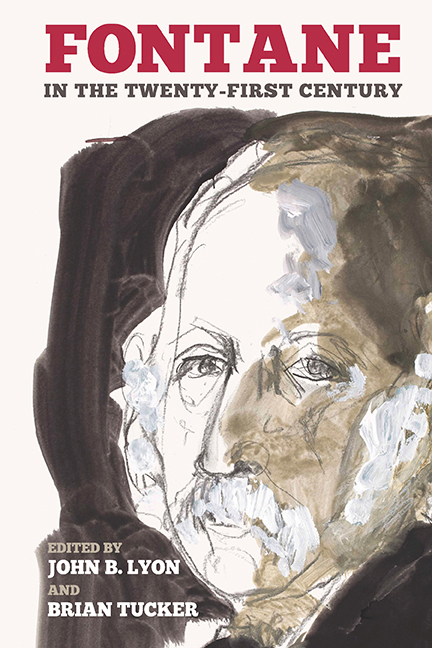Book contents
- Frontmatter
- Contents
- Acknowledgments
- Note on Editions
- Introduction: Fontane in the Twenty–First Century
- 1 Narrative Digression and the Transformation of Nationhood in Vor dem Sturm
- 2 Nasty Women: Female Anger as Moral Judgment in Grete Minde and Effi Briest
- 3 Performing the Philistine: Gossip as a Narrative Device and a Strategy for Reflection on Anti-Semitism in Theodor Fontane's L'Adultera
- 4 To Have an Eye: Visual Culture and the Misapprehension of Class in Irrungen, Wirrungen
- 5 Fontane as a Pacifist? The Antiwar Message in Quitt (1890) and Fontane's Changing Attitude to Militarism
- 6 Disjunctive Transnationalisms in Fontane's Frau Jenny Treibel
- 7 On the “Right Measure” in Effi Briest: Ethics and Aesthetics of the Prosaic
- 8 Transfiguration, Effect, and Engagement: Theodor Fontane's Aesthetic Thought
- 9 Fontane and World Literature: Prussians, Jews, and the Specter of Africa in Die Poggenpuhls
- 10 Von Zwanzig bis Dreißig: The Male Author in Parts
- 11 Melusine von Barby's Barriers and Connections in Fontane's Der Stechlin
- 12 Senescence and Fontane's Der Stechlin
- Notes on the Contributors
- Index
4 - To Have an Eye: Visual Culture and the Misapprehension of Class in Irrungen, Wirrungen
Published online by Cambridge University Press: 31 August 2019
- Frontmatter
- Contents
- Acknowledgments
- Note on Editions
- Introduction: Fontane in the Twenty–First Century
- 1 Narrative Digression and the Transformation of Nationhood in Vor dem Sturm
- 2 Nasty Women: Female Anger as Moral Judgment in Grete Minde and Effi Briest
- 3 Performing the Philistine: Gossip as a Narrative Device and a Strategy for Reflection on Anti-Semitism in Theodor Fontane's L'Adultera
- 4 To Have an Eye: Visual Culture and the Misapprehension of Class in Irrungen, Wirrungen
- 5 Fontane as a Pacifist? The Antiwar Message in Quitt (1890) and Fontane's Changing Attitude to Militarism
- 6 Disjunctive Transnationalisms in Fontane's Frau Jenny Treibel
- 7 On the “Right Measure” in Effi Briest: Ethics and Aesthetics of the Prosaic
- 8 Transfiguration, Effect, and Engagement: Theodor Fontane's Aesthetic Thought
- 9 Fontane and World Literature: Prussians, Jews, and the Specter of Africa in Die Poggenpuhls
- 10 Von Zwanzig bis Dreißig: The Male Author in Parts
- 11 Melusine von Barby's Barriers and Connections in Fontane's Der Stechlin
- 12 Senescence and Fontane's Der Stechlin
- Notes on the Contributors
- Index
Summary
IN HIS WRITINGS on literature and art, Theodor Fontane favors representations that are straightforward, reliable, and effective. Indeed, he describes the modern novel's task as one of providing “ein unverzerrtes Wiederspiel des Lebens …, das wir führen” (NA, 21.2:653; an undistorted counterpart of the life that we lead). It is interesting, then, that over and against this penchant for truthful representation, Irrungen, Wirrungen (1888, Delusions Confusions, published in English as On Tangled Paths, 2010) problematizes the acts of sight and perception. The novel suggests that vision—the most trusted of the human senses—is not nearly as reliable as one might assume.
The novel emphasizes the limits of visual capacity in a variety of ways, one of which is the characters’ repeated assertion that one must “have an eye for something.” It voices the conviction that seeing is not a neutral window onto the objects of the world but rather that one's sight is limited, fragmented, and socially contingent. Nowhere are the limitations of perception more apparent than in Botho von Rienäcker, and never are they more obvious than when he observes the working class. Botho, it seems, “has no eye” for labor, for the reality of workingclass life. In this chapter I argue that the novel constructs his way of seeing from various visual cues, including his enthusiasm for the landscape painter Andreas Achenbach. Like Achenbach portraying a modest house in a bucolic landscape, Botho cannot help but idealize and romanticize the lives of the working class. He unstintingly sees them through a stylized, aesthetic lens.
In this inquiry I engage with two prominent strains within Fontane scholarship—on the one hand, with work on Fontane's depictions of landscape and place, and on the other, with the issue of authenticity and superficiality within the novel. Irrungen, Wirrungen's central tension falls on the contrast between Lene and Käthe, two characters who embody opposed social classes, speech patterns, and ways of being in the world. Lene is often taken as an alternative to the idle chatter of the upper classes, as a reservoir of authenticity in a frivolous world. Much of the reader's access to Lene's positive qualities, however, comes through Botho's observations.
- Type
- Chapter
- Information
- Fontane in the Twenty-First Century , pp. 63 - 83Publisher: Boydell & BrewerPrint publication year: 2019



